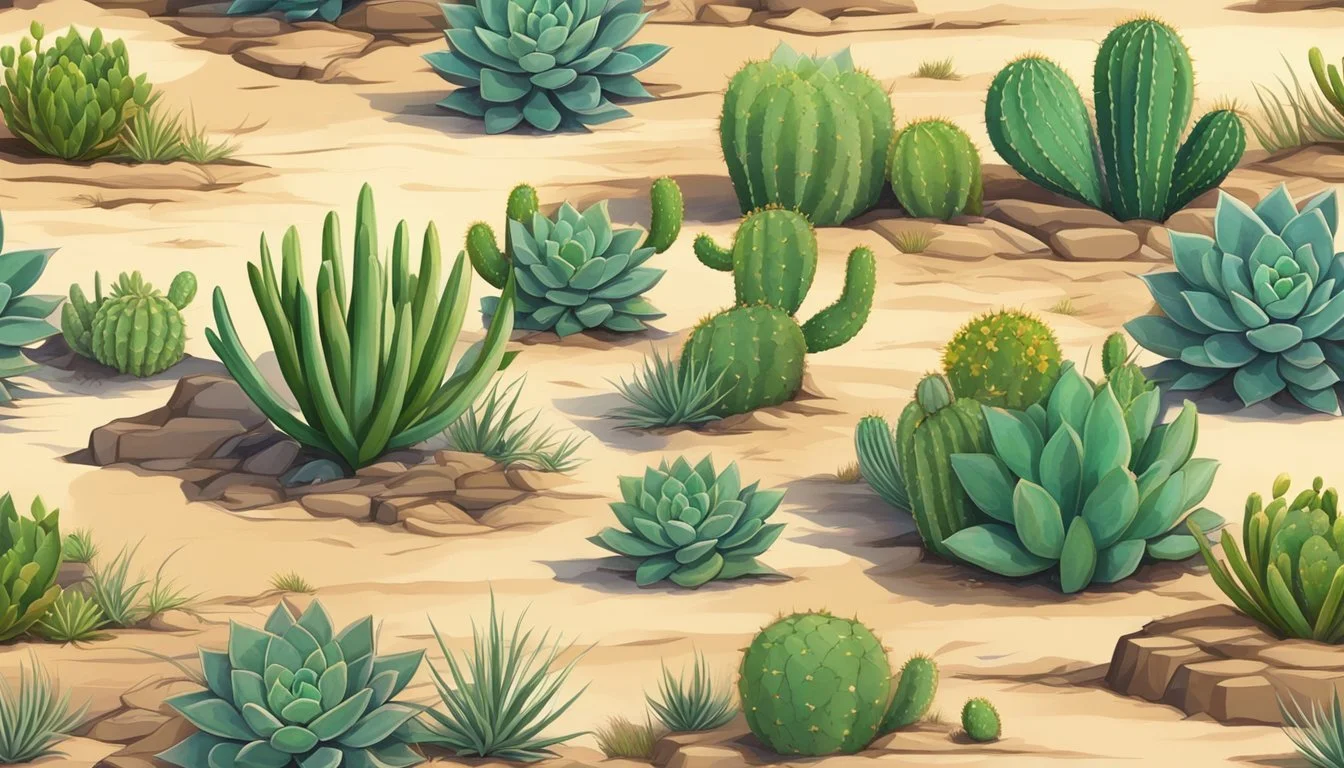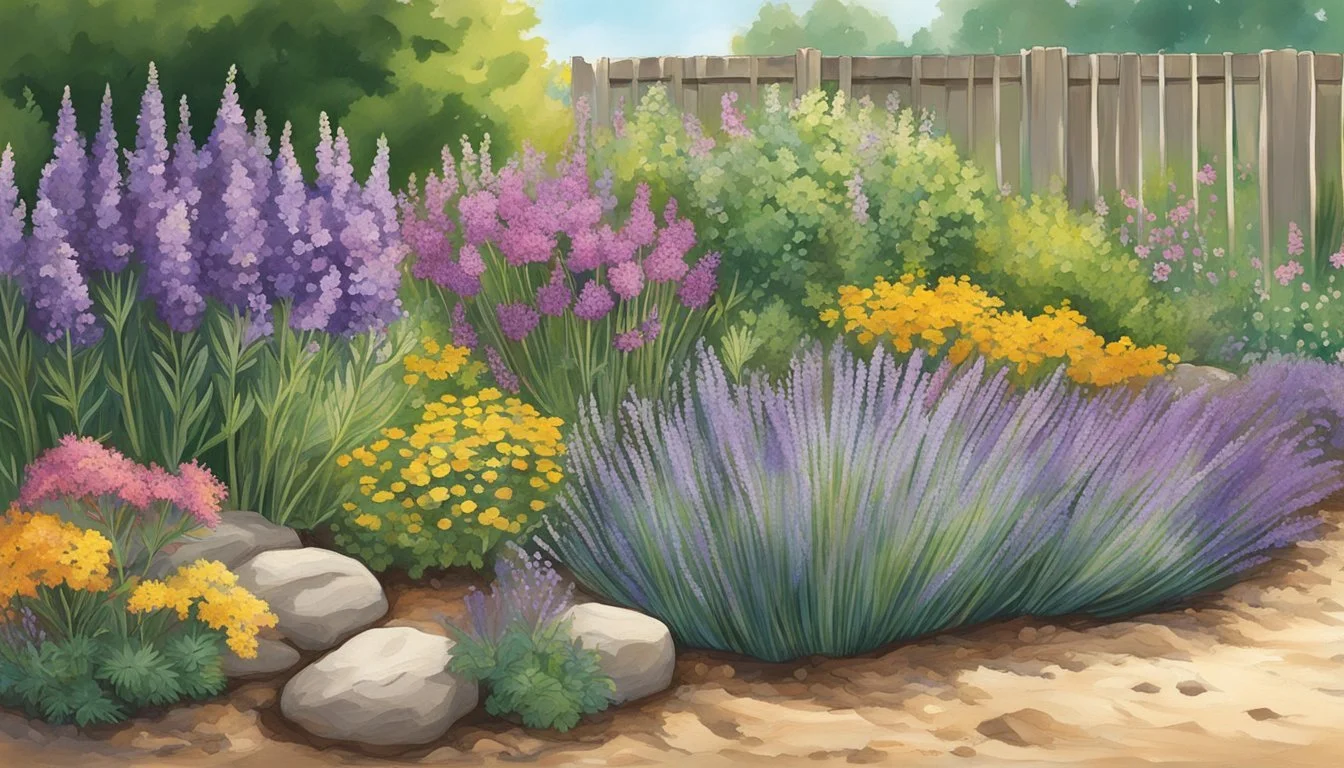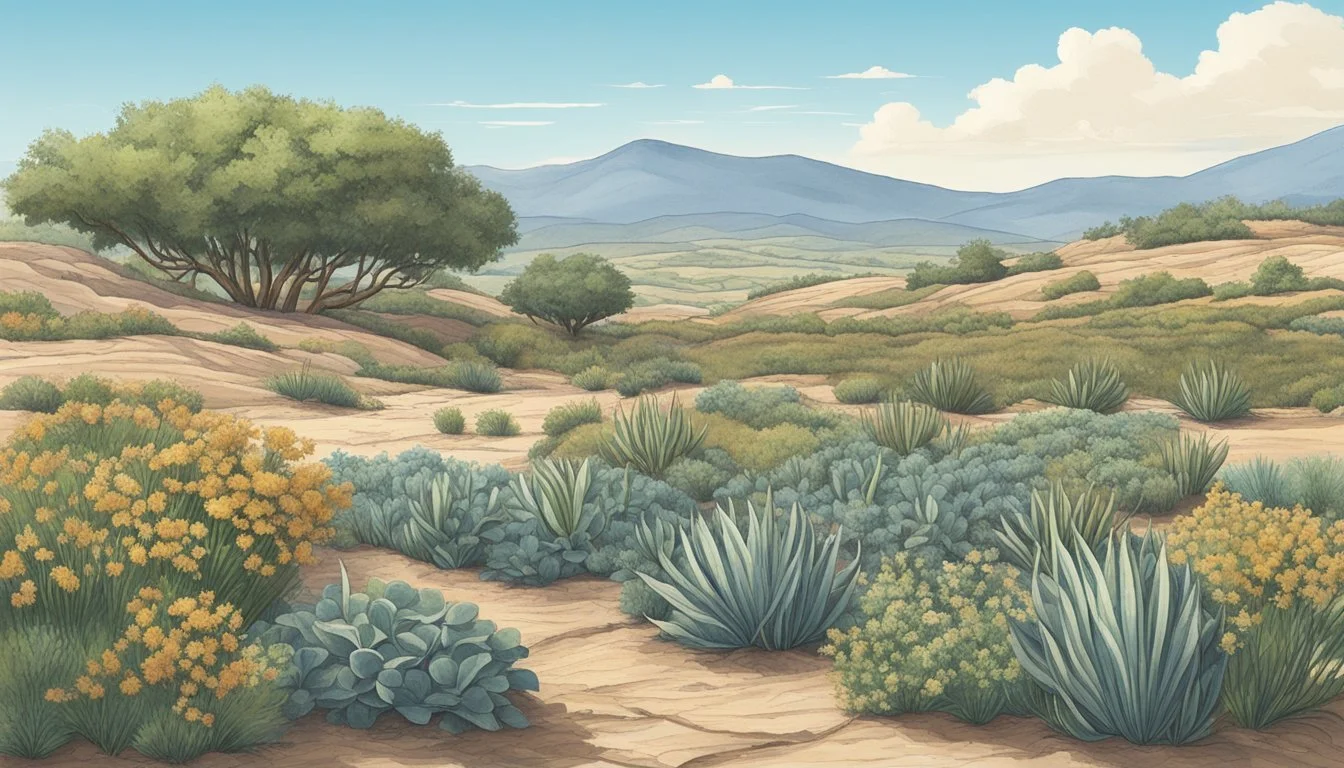Drought-Tolerant Plants in Pennsylvania
Thriving Species for a Changing Climate
As climate patterns fluctuate and periods of low precipitation become more common, gardeners and landscapers in Pennsylvania are turning their attention to drought-tolerant plants. These resilient species provide an effective solution for maintaining beautiful and healthy gardens that require less water. By leveraging the natural hardiness of these plants, one can create a landscape that is not only environmentally sustainable but also economically beneficial, as it reduces water usage and maintenance costs.
Drought-tolerant plants come in a wide variety, from deep-rooted trees that can tap into water reserves to succulents that store moisture in their leaves. Pennsylvania's climate, which can range from humid summers to cold winters, poses unique challenges for gardeners seeking flora that can thrive with minimal irrigation. Fortunately, options abound for those looking to cultivate a garden filled with plants that are both aesthetically pleasing and adapted to drier conditions.
Understanding Drought and Its Effects on Flora
Drought has unmistakable impacts on flora, as it represents periods where water availability is significantly below the normal levels. In Pennsylvania, the climate can play a significant role in the frequency and severity of drought conditions. Drought conditions can reduce rainfall drastically, an essential component for plant survival.
Soil type also influences how flora responds to drought. Certain soils can retain moisture better than others, providing some relief to plants during dry spells. However, when prolonged drought occurs, even the most resilient soils might not provide enough moisture to support plant life.
Pennsylvania's flora has varying levels of drought tolerance. Some native species are adapted to withstand dry periods, while others may suffer without adequate water. Here's a brief overview of how different types of plants are affected:
Trees: Slower growth, leaves may wilt or fall off to conserve water.
Shrubs: Similar to trees, may also go dormant until conditions improve.
Grasses: Can turn brown and dormant, but usually recover quickly after rain.
Flowers: May have stunted growth or fail to bloom; some may not survive extended drought.
During drought, plants take specific actions to survive, such as closing their stomata, leaf shedding or developing deeper root systems to access lower soil moisture. There's also a metabolic shift; growth processes slow down, and energy is conserved for essential functions.
It's vital to recognize that the interaction between climate, soil type, and plant adaptations determines the resilience of Pennsylvania's flora to drought. Understanding these parameters aids in preparing and mitigating the adverse effects of drought on plant life.
Fundamentals of Drought-Tolerant Landscaping
Creating a drought-tolerant landscape is an environmentally friendly approach to gardening that conserves water and thrives with little maintenance. The key components include selecting the right plants, optimizing soil, and designing an efficient layout.
Native Plants: They are central to drought-tolerant landscaping in Pennsylvania. Utilizing plants such as Purple Coneflower or Pennsylvania Sedge means landscaping with species adapted to the regional climate and soil conditions, requiring less water and care than non-native species.
Soil Preparation: Amending the soil with organic matter improves its water retention and drainage capabilities, both critical for drought tolerance. It also provides the necessary nutrients for plants to grow strong and resilient.
Water Conservation: This goes beyond plant selection. It involves installing efficient irrigation systems like drip irrigation or soaker hoses that deliver water directly to plant roots, minimizing waste. Mulching is also critical; it reduces evaporation, keeps roots cool, and suppresses weeds.
Design and Space: A considered layout is pivotal. Grouping plants with similar water needs together can optimize water usage. Creating zones in the landscape that require no additional watering beyond natural rainfall, known as hydrozoning, is a strategic approach to managing resources efficiently.
Low-Maintenance: The goal is to reduce the need for resources such as water, fertilizer, and time. Drought-tolerant landscapes achieve this by embracing simplicity and functionality in design.
Incorporating these elements helps individuals achieve a successful and sustainable drought-tolerant landscape. It's a conscientious choice that supports a harmonious relationship between one's garden and the environment.
Characteristics of Drought-Tolerant Plants
Drought-tolerant plants possess specific adaptations that enable them to thrive in environments with limited water availability. These specialized features often include deep and extensive root systems, leaves structurally designed to reduce water loss, and growth patterns conducive to survival under arid conditions.
Root Systems
Drought-tolerant species typically exhibit robust root systems that extend deep into the soil, allowing them to access moisture that other plants cannot reach. For example, the Bur Oak taps into underground water sources through a root system that may grow several times the height of the tree itself. This adaptation is crucial for survival in full sun and dry climates where surface moisture is a rarity.
Leaf Structures
The leaves of drought-tolerant plants display a variety of structural modifications to minimize water loss. Some species, like Forsythia, have smaller, thicker leaves with a waxy coating that reduces evaporation. Others may have leaves that are gray or silver, reflecting sunlight and thus reducing heat absorption and moisture loss.
Growth Patterns
Drought-tolerant perennials typically grow at a slower rate, conserving energy and requiring less moisture to sustain their development. Plants like the Japanese Tree Lilac invest energy in establishing a strong foundation before producing large clusters of creamy white flowers. These plants are adapted to survive prolonged periods of high temperatures and drying winds, conditions common in drought-prone areas.
Native Drought-Tolerant Plants of Pennsylvania
Pennsylvania landscapes can flourish with a variety of native trees, shrubs, grasses, perennials, and flowers that are well-suited to its climate and less demanding in terms of water requirements.
Trees and Shrubs
Green Hawthorn (Crataegus viridis 'Winter King'): This hearty tree offers seasonal colors and can withstand periods of low moisture once established.
Gray Dogwood (Cornus racemosa): As a resilient native shrub, gray dogwood is adaptable to a variety of soil conditions including those experiencing drought.
Grasses and Ground Covers
Juniper (Juniperus spp.): Robust and evergreen, junipers serve as excellent ground covers, with certain species native to Pennsylvania tolerating dry conditions.
Perennials and Flowers
Perennials: Select native perennials like the butterfly milkweed provide vibrant colors and are drought-tolerant once they have settled into their habitat.
Flowers: The coneflower thrives in Pennsylvania's climate, requiring minimal watering and offering a feast of nectar for local pollinators.
Choosing Plants for Your Garden
When planning a Pennsylvania garden, one must consider the sunlight exposure and the resilience of plants to drought conditions. Proper selection based on these criteria ensures a thriving garden with minimal watering.
For Full Sun Exposure
In full sun areas, gardens receive at least six to eight hours of direct sunlight daily. For these conditions, drought-tolerant plants that can thrive in full sun are essential.
Sedums are an excellent choice for full sun and require minimal watering. One variety, known as "Autumn Joy", offers rosy-pink blooms which can add late-season color to your garden.
Another suitable option is the Garden Zinnia (Zinnia elegans), which is not only heat and drought-tolerant but can also provide a vibrant display with minimal upkeep.
These plants require well-draining soil to prevent waterlogging and to support their drought-tolerant nature.
For Shaded Areas
Shade in the garden does not equate to a lack of options. There are plants that can flourish with limited sunlight, often requiring less water due to reduced evaporation rates under the canopy cover.
Native shrubs and other plants can preserve biodiversity and are well-adapted to the area’s shadier spots. They also contribute to a garden's ecological health by supporting local wildlife.
For ground cover in shaded areas, consider drought-tolerant varieties that can also handle lower light levels. One can opt for jewel-toned foliage or flowering plants that can brighten up these spaces while requiring minimal additional watering attention.
Always choose a location that can offer your shade-loving plants the required conditions while considering the soil quality to maintain their health and drought tolerance.
Cultivation and Care for Drought-Tolerant Species
Successful cultivation of drought-tolerant plants in Pennsylvania hinges on specific preparation and maintenance strategies. Understanding the nuances of soil preparation, moisture management, and ground coverage is essential for the health and vibrancy of these resilient species.
Soil Preparation and Improvement
Soil quality directly impacts the growth of drought-tolerant plants. They thrive in well-draining soil that prevents waterlogging. Begin with a soil test to assess nutrient levels and pH. Amend the soil with compost to improve its structure which promotes root development and aids in water retention. Incorporating a balanced slow-release fertilizer can encourage healthy growth without the risk of excessive nutrient run-off.
Soil Attributes: Loamy, sandy, well-draining
Amendments: Organic compost, balanced fertilizer
Watering and Moisture Management
Although drought-tolerant, these plants do require watering to establish deep root systems. Employ a strategy of infrequent but deep watering to encourage roots to grow downward, seeking moisture. Once established, reduce watering frequency, allowing the soil to dry between watering sessions. This cultivates plants that are resilient to drought conditions.
Initial Watering: Deeply and infrequently
Established Plants: Water sparingly, allowing soil to dry out
Mulching and Ground Coverage
Mulch serves as a protective barrier that conserves soil moisture, regulates temperature, and deters weed growth. Apply a 2 to 3-inch layer of organic mulch like shredded bark or straw around the base of your plants. This practice is crucial in maintaining existing moisture levels without requiring frequent watering. Additionally, selecting drought-friendly ground cover plants can provide similar benefits to mulch while adding aesthetic value to your garden.
Mulch Type: Organic, such as shredded bark or straw
Thickness: 2 to 3 inches
Supporting Wildlife and Ecosystems
In Pennsylvania, integrating drought-tolerant plants within landscaping strategies significantly enhances support for local wildlife, particularly those species that are vital pollinators and beneficial insects. Such plants offer sustenance and refuge, fostering a balanced ecosystem even in dry conditions.
Attracting Pollinators
Butterflies and bees, key pollinators in the ecosystem, thrive when drought-tolerant native plants are present. Keystone species, like those mentioned by Dr. Doug Tallamy, support a substantial population of these pollinators. One can encourage a diverse range of pollinators by planting in clusters to provide larger feeding grounds. Notably, plants like the Butterfly Bush bloom from summer to fall, which not only benefits pollinators like butterflies but also enhances the visual appeal of gardens.
Providing Habitat for Birds and Insects
Drought-tolerant native plants often double as habitats for various birds and insects. Their robust nature allows them to maintain structure and provide shelter and nesting spots for birds, even in arid periods. Insects also rely on these plants for cover and as a food source, with some species, as highlighted in Pennsylvania's native flora, demonstrating resilience and minimal maintenance. This harmonious balance ensures that native wildlife can prosper in gardens tailored to withstand drought conditions.
Color and Aesthetics in Drought-Resistant Gardens
Creating a drought-resistant garden in Pennsylvania does not mean compromising on vibrancy and aesthetic appeal. The selection of plants can offer a kaleidoscope of colors and textures, ensuring that low-water landscapes are not only practical but also beautiful.
Vibrant Flowering Plants
Drought-tolerant gardens can boast a variety of vibrant flowering plants that add bursts of color throughout the seasons. For instance, the Salvia spp. provides a range of hues including rich purples that combine well with the Achillea spp., known for their pink blooms and yellow flowers. These perennials are not only resilient but also attract pollinators, enhancing the garden's biodiversity.
Foliage Color Variation
Beyond flowers, foliage plays a critical role in the garden's palette. Plants like Sedum offer soft green to gray leaves, forming a textured carpet that contrasts with darker greens or other colorful plantings. The variation in foliage color creates a backdrop that highlights the seasonal blooming of nearby flowers, making the garden's colors pop.
Arrangement and Design
In a drought-resistant garden, arrangement and design are key to a cohesive look. Grouping plants with similar water needs yet diverse colors and textures can create a stunning visual impact. For instance, pairing the silver-gray Wormwood with the brighter, more vivid Spurge establishes a contrast that enlivens the space. Strategic placement ensures that each plant's unique characteristics contribute to the overall design.
Seasonal Considerations
Selecting the right drought-tolerant plants for Pennsylvania involves understanding their seasonal care requirements. From spring watering strategies to winter protection, each season offers unique challenges and opportunities.
Spring and Summer Care
In late spring and summer, these plants require attention to ensure they're established and can withstand dry conditions. Here are some specific actions to take during these seasons:
Spring:
Gradually reduce watering frequency to encourage deep root growth.
Apply mulch to conserve soil moisture and reduce weed competition.
Summer:
Provide full sun exposure, as many drought-resistant species thrive in intense sunlight.
Monitor plants for signs of stress during peak drought periods and water deeply when necessary.
Fall and Winter Preparation
As the seasons transition to late fall and into winter, these plants need preparation to survive the colder months:
Fall:
Decrease watering to harden off the plants in anticipation of winter.
Apply a fresh layer of mulch to insulate root systems from freezing temperatures.
Winter:
Avoid overwatering, which can be detrimental during periods of dormancy.
Conduct visual checks for winter damage and address issues promptly to ensure plant vigor in the spring.
Ecological Benefits and Sustainability
Incorporating drought-tolerant plants in Pennsylvania landscapes presents numerous ecological benefits and bolsters sustainability efforts. These plants are adept at surviving in arid conditions, which notably conserve water resources. By requiring fewer water inputs, they are a responsible choice for gardeners looking to maintain lush gardens without excess water use.
Native plants are particularly important for ecological sustainability. They are well-adapted to local environments and support diverse ecosystems by providing habitats and food for native wildlife. A list of trees, shrubs, annuals, and perennials that thrive in Pennsylvania’s conditions can be found through Penn State Extension.
Diversity in plant selection is key to a resilient garden. By blending various types of drought-tolerant plants, one ensures a green space that sustains itself through different challenges, such as pests, diseases, and changing climate conditions.
Water Conservation: Reduces the dependency on water supply, preserving it for essential uses.
Support for Native Wildlife: Provides food and shelter for local birds, insects, and other fauna.
Lower Maintenance: Requires less intervention in terms of watering, fertilizing, and other care.
Enhanced Ecosystem Services: Improves air quality, soil health, and contributes to carbon sequestration.
By favoring green solutions that are eco-friendly and sustainable, gardeners and landscape designers in Pennsylvania help to create more robust ecosystems and contribute positively to environmental health. Drought-tolerant plants are a pragmatic, yet effective step in this direction.
Common Challenges and Solutions
When cultivating drought-tolerant plants in Pennsylvania, gardeners often face three main challenges: managing pests, preventing diseases, and controlling weeds. These issues can threaten the health and productivity of plants, even those adapted to dry conditions. Effective strategies are essential to maintain a thriving garden.
Pest Management
Drought-tolerant plants still fall victim to pests in Pennsylvania, such as aphids and spider mites. These pests can exacerbate stress on plants already dealing with low moisture levels. The use of natural predators like lady beetles can provide control without harming the plants. Additionally, applying insecticidal soaps or horticultural oils during cooler parts of the day minimizes impact on beneficial insects while targeting the harmful pests.
Disease Prevention
Diseases, often exacerbated by drought stress, can hinder plant development and reduce vigor. To prevent disease, gardeners should select plant varieties known for disease resistance and implement crop rotation techniques to minimize pathogen buildup in the soil. Regular monitoring and the use of fungicides can also be beneficial as preventive measures but should be applied judiciously to avoid unnecessary chemical use.
Managing Weeds
Weeds not only compete with drought-tolerant plants for nutrients and water, but also for light and space. Mulching is an effective practice to suppress weed growth and retain soil moisture. The strategic application of pre-emergent or post-emergent herbicides can be employed but should be used carefully to avoid damaging desired plants or the environment. For the best results, one should also regularly remove weeds before they have a chance to seed.
Frequently Asked Questions
In Pennsylvania, gardeners often seek plants that can thrive in the state's variable weather conditions. Below are commonly asked questions addressing the selection of drought-tolerant plants suitable for Pennsylvania gardens.
What are some low maintenance, drought-tolerant perennials for Pennsylvania?
Perennials like beardtongue (Penstemon) and butterfly weed (Asclepias tuberosa) are noted for their drought tolerance and low maintenance, making them ideal for Pennsylvania gardens.
Can you list some drought-tolerant evergreen plants suitable for Pennsylvania's climate?
Drought-tolerant evergreens like Eastern red cedar (Juniperus virginiana) and Blue spruce (Picea pungens) are suitable for Pennsylvania's climate, providing year-round foliage and resilience in drier conditions.
What are the best shrubs to plant in Pennsylvania that can withstand full sun and dry conditions?
Shrubs such as creeping juniper (Juniperus horizontalis) and barberry (Berberis spp.) are among the best to plant in Pennsylvania for withstanding full sun and dry conditions.
Are there any native ground covers for Pennsylvania that are resistant to drought?
Pennsylvania native ground covers, such as green and gold (Chrysogonum virginianum), are known for their resistance to drought and can be dependable choices for challenging garden spots.
What varieties of drought-tolerant plants are recommended for container gardening in Pennsylvania?
For container gardening, drought-tolerant plants like sedum and gaillardia are recommended as they are adaptable and require minimal watering, making them suitable for Pennsylvania's variable climate.
Which perennials thrive in Pennsylvania's climate, handling both full sun and heat?
Perennials such as Sandy Feather (extension educator in Allegheny county) and yarrow (Achillea spp.) are known to thrive in Pennsylvania's climate, enduring both full sun and high temperatures.













